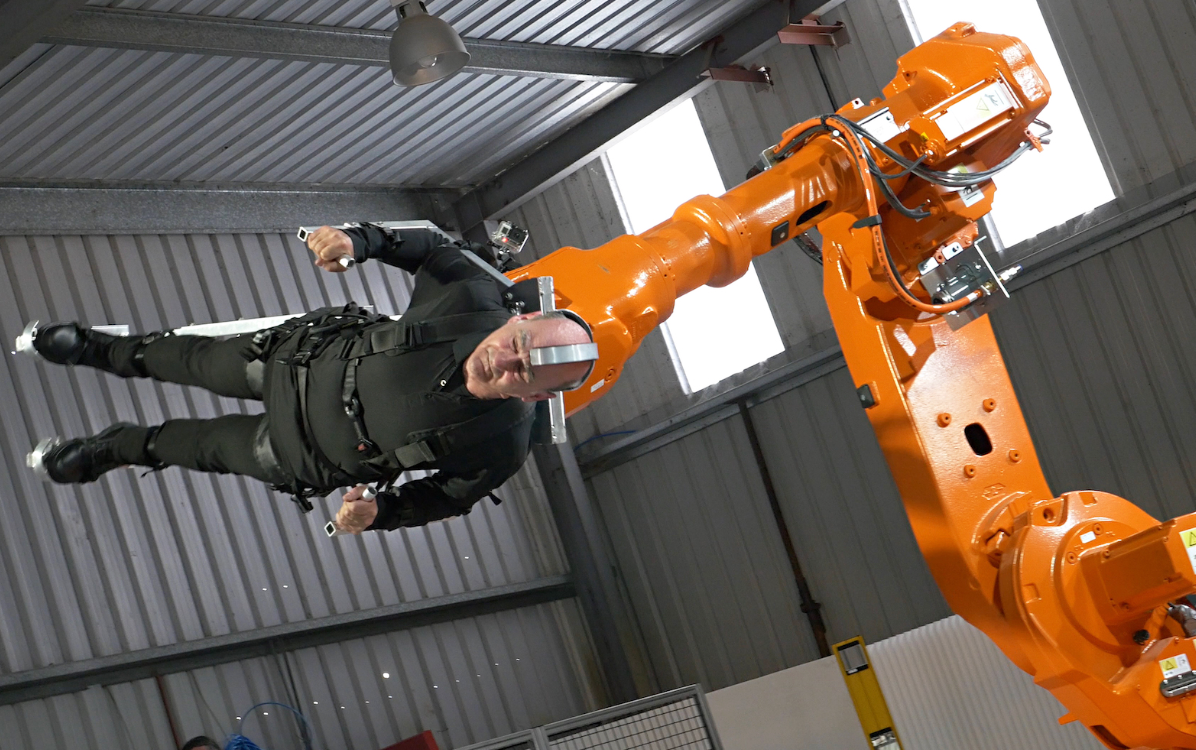An Interview with Stelarc
Aimee Resnick (she/her) - May 10, 2023
Stelarc is a world-renowned Australia-based performance artist engaged at the intersection between the human body, the technological, and the prosthetic. Over the years, he has utilized virtual reality, robotics, the internet, Second Life, and 26 flesh-hook suspension performances to challenge notions of the human body. This week, we sat down to discuss his famous third ear, human autonomy, and bodily obsolescence.
NAR: Your famous claim is that “the human body is obsolete." Do you think there is any corporal idea that cannot be replicated by science?
Stelarc: When I assert that the body is obsolete, I mean that this body, in this form and these functions, is inadequate in the modern technological terrain it performs in. The body is augmented and amplified by machines, instruments and computational systems.
Technology is not an alien other, but, as Marshall McLuhan observes, the external organs of the body. We evolved as soft biological bodies with internal organs: but now it is necessary to engineer external organs to extend our operations in the world. Neither technology nor science can be amputated from the human.
The body has always been a prosthetic body, extended by its technology. Replication, biomimicry is one strategy that science is taking. What’s more interesting is the unexpected outcome of this hybridity. New instruments generate new information and images and lead to ideas we never could have imagined. We couldn’t have imagined electronically dissecting a living body nor fabrication on a nano-scale
NAR: Let’s talk about the ear. In 2006, you had an ear created from stem cells and implanted directly into your arm: the modification is not for you, though, but was instead designed so that others may tune-in to a 24-hour live-stream of what it hears. Is this plan still in motion? How do you believe the digitalization of the body relates to governmental surveillance?
Stelarc: Just to clarify, the Ear on Arm project (2006) was surgically constructed with tissue ingrowth and vascularisation. It is a living part of my body. But yes, the idea of electronically augmenting it to make it internet-enabled is still being explored. There are still issues with scale, technology and biomedicine that have not been resolved for the idea to be elegantly engineered.
And, yes, the idea was never for me to have an extra ear (I have two perfectly good ears to hear with), but rather to construct a remote listening device for other people. Sometimes ideas exceed actualisation, although as a performance artist, ideas themselves are often easy. What’s meaningful is to perform them, to truly experience what it means to have remote interactivity and be able to articulate further possibilities.
We need to be wary of government surveillance, especially in autocratic and capitalist countries; but we must also understand that as we inhabit increasingly complex terrains, we must expect more kinds of control to interact effectively with others and machines.
Perhaps we don’t need more public surveillance, but we certainly need more internal surveillance of our bodies to better monitor and alert us to pathological conditions.
NAR: Tell me about Second Life. Do you feel it is an adequate replacement for real-world social interactions? Where does it surpass and fail to fulfill the human need for belonging?
Stelarc: Second Life isn’t an adequate replacement, but it can become an alternative and effective mode of operation. We are increasingly expected to perform in Mixed Realities. There’s a necessity to seamlessly slide between the actual, the computational, and the virtual.
Second Life is an online platform that allows remote interaction with other avatars. It’s a site where you can construct your own virtual space and populate it with interactive objects. Without the physical and identity constraints of the real world, you can explore fluidity in personal and social experiences. You can perform in more cinematic and CGI ways. Floating, flying and teleporting are easy and seductive operations to perform and experience.
Second Life shouldn’t be considered an impoverished real life, but rather an additional mode of operation. It’s an alternative way to experience others elsewhere. What I consider more interesting is the possibility of inverting the typical actual-virtual system. Imagine an avatar, imbued with artificial intelligence, being able to access a physical body performing in the real world. An inverse motion capture system.
Movatar was a performance that explored this idea: the upper-half of my body was actuated by my digital avatar while the lower-half was actuated by my own agency. It was not a split between mind and body, but rather a split-body experience.
NAR: Help me understand your suspension practices. What do we gain by relinquishing control? Do we ever truly have control in the first place, or do we simply not notice the natural limitations imposed by our bodies?
Stelarc: The suspensions were not so much about control, but rather the physical difficulty of actualising an idea. I perform a posture of indifference. Indifference, here, is not negative: it’s simply an opposition to expectation. I allow the performance to unfold in its own time and with its own rhythm.
Certainly, it was necessary for others to be part of the process. The issue was thereby about relinquishing control but about trust. I couldn’t resort to any methods of bodily control nor any anaesthetic. The body remains exactly the same before, during, and after the suspension. No transcendental urges.
As a performance artist, you have to assume the physical consequences of your ideas. We certainly plan, but there’s a point when thinking stops and the event begins.
During City Suspension, the body was suspended and rotated 60 meters above the Royal Theatre. There was no testing before the performance. After 30 meters in the air, all I could hear was the whooshing of the wind, the whirring of the crane arm, and the creaking of the skin.
And with the internet performance of Fractal Flesh: people in other places could access the body and remotely choreograph its movements. The question was not about who was in control, but rather about how to construct a more complex and extended system of operational bodies spatially-separated but electronically-connected.
The more recent StickMan / miniStickMan performance involved a minimal full-body exoskeleton that algorithmically actuated the body for a continuous five hour performance. Visitors to the gallery could manipulate the miniStickMan interface and insert their choreography.
All of these actions problematise what a body is and how a body performs in the world. It’s simplistic to imagine that we have minds of our own and act as free agents. We are conscious agents but we are not necessarily in control. We are part of a more complex world of powerful natural events, competing agents, and technological agents that propel and prompt and generate our behavioural responses.
NAR: At the time, your Stomach Sculpture was cutting-edge. Now, it is a normal day at the doctor's office. What other practices that seem strange today will become normalized tomorrow?
Stelarc: The Stomach Sculpture was a custom object that, when safely inserted inside the stomach, could open and close, extend and retract, flash a light, and emit a beeping sound. A simple machine choreography inside the soft organ of the body.
Thus, the body was no longer simply a site for the psyche or for social interaction. It became a site for sculpture, the host of its own artwork. A sculpture that was not created for a public site but for a private space. In general, the work was a response to the theme of the Sculpture Triennial: site-specific works.
The most difficult aspect was that a medical endoscope was used to document the insertion of the sculpture down the esophagus into the stomach cavity. That proved to be extremely uncomfortable, as the control cable was 8mm in diameter and the endoscope was an additional 10mm. It took 6 insertions over 2 days to shoot 15 minutes of video. The challenge with the Stomach Sculpture was that it occupied most of the internal space of the stomach when fully deployed.
What is now increasingly plausible, with microminiaturisation and nano-scaling, is that we might recolonise the body with sensors to augment our bacterial populations. In this way, we could better monitor pathological conditions detected at cellular level. This is an example of how we might not need more public surveillance, but we certainly need more internal surveillance.
What’s more interesting, though, is the use of nano machines to redesign the body, atoms-up, inside-out. The process would be invisible and so incremental that you couldn’t sense what was happening until the changes surfaced to skin level.
NAR: Is the human body intrinsically art? Where do you draw the line between ornamental modification and ornamental existence?
Stelarc: Oh, I wouldn’t say that the body is intrinsically art, but its actions are. All of my projects and performances are aesthetic gestures to alternative anatomical architectures and their unexpected possibilities.
Note that the body modification community is experimenting not only with surface ornaments such as tattoos and scarifications, but also with sculptural augmentations like silicone implants. So there’s a trajectory of practice going beyond the mere ornamental.
It’s symptomatic of seeing the body as a site of fundamental difference. It doens’t merely express desire for a freedom of idea but also desire for a freedom of form – freedom to modify and make more unique one’s own individual body. Modification isn’t a mere cosmetic desires, but an ornamental existence…
NAR: Can data be separated from real life? Are data and experiences disparate or identical?
Stelarc: Data is the contemporary way of computationally describing, measuring, and acting upon the world. In a way, data and experiences are coupled, but not identical. It’s problematic to reduce life to bits of information or mathematical formulae. Science seems to do that by simplifying the world into elements that are useful and predictable, but it’s through embodied expereriences that we have existence in the world.
Data can’t be equated with sensing, feeling, and the thinking. But it can describe and communicate as a means of comprehension. Data can quantify our qualitative experiences.
Within the field of computer science, what’s important is how information can be compressed, encoded and transmitted. Claude Shannon considered information to be the resolution of uncertainty. Information needs to be processed to become meaningful. By definition, what’s meaningful in any information is the capacity to surprise.
NAR: In the age of AI, what defines humanity? Do you need to have a tangible body to be human?
Stelarc: To be an intelligent agent, you need to be both embodied and embedded in the world. Still, there are alternative anatomical and machine architectures can interact and operate. For example, insects and animals construct and respond to the world in very disparate ways from humans.
AI still needs some kind of substrate to actualise its operations. Whether in robot form or online stature. What I am curious to see is if AI will develop an alien intelligence of its own and surpass human cortical capabilities. Although SETI is premised on the possibility of life on other planets, the first signs of alien life may form here.
At any rate, what it means to be a body, what it means to be human, is constantly reimagined and reconfigured. Genetic, social, cultural and technological factors determine civilization. The human is an unstable historical construct.






